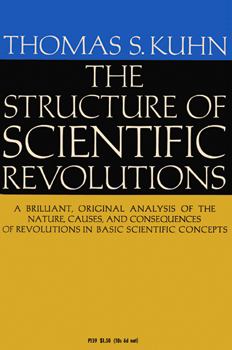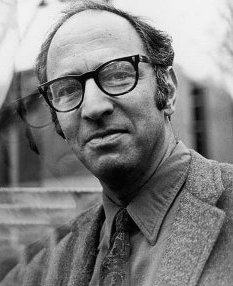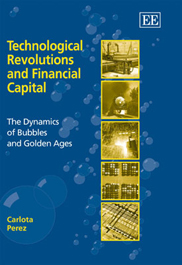Related Research Articles
A paradigm shift is a fundamental change in the basic concepts and experimental practices of a scientific discipline. It is a concept in the philosophy of science that was introduced and brought into the common lexicon by the American physicist and philosopher Thomas Kuhn. Even though Kuhn restricted the use of the term to the natural sciences, the concept of a paradigm shift has also been used in numerous non-scientific contexts to describe a profound change in a fundamental model or perception of events.
Normal science, identified and elaborated on by Thomas Samuel Kuhn in The Structure of Scientific Revolutions, is the regular work of scientists theorizing, observing, and experimenting within a settled paradigm or explanatory framework. Regarding science as puzzle-solving, Kuhn explained normal science as slowly accumulating detail in accord with established broad theory, without questioning or challenging the underlying assumptions of that theory.
In science and philosophy, a paradigm is a distinct set of concepts or thought patterns, including theories, research methods, postulates, and standards for what constitute legitimate contributions to a field. The word paradigm is Greek in origin, meaning "pattern", and is used to illustrate similar occurrences.

The Structure of Scientific Revolutions is a book about the history of science by philosopher Thomas S. Kuhn. Its publication was a landmark event in the history, philosophy, and sociology of science. Kuhn challenged the then prevailing view of progress in science in which scientific progress was viewed as "development-by-accumulation" of accepted facts and theories. Kuhn argued for an episodic model in which periods of conceptual continuity where there is cumulative progress, which Kuhn referred to as periods of "normal science", were interrupted by periods of revolutionary science. The discovery of "anomalies" during revolutions in science leads to new paradigms. New paradigms then ask new questions of old data, move beyond the mere "puzzle-solving" of the previous paradigm, change the rules of the game and the "map" directing new research.
The concept of the innovation system stresses that the flow of technology and information among people, enterprises, and institutions is key to an innovative process. It contains the interactions between the actors needed in order to turn an idea into a process, product, or service on the market.

Carlota Perez is a British-Venezuelan scholar specialized in technology and socio-economic development. She researches the concept of Techno-Economic Paradigm Shifts and the theory of great surges, a further development of Schumpeter's work on Kondratieff waves. In 2012 she was awarded the Silver Kondratieff Medal by the International N. D. Kondratieff Foundation and in 2021 she was awarded an Honorary Doctorate by Utrecht University.
Technological change (TC) or technological development is the overall process of invention, innovation and diffusion of technology or processes. In essence, technological change covers the invention of technologies and their commercialization or release as open source via research and development, the continual improvement of technologies, and the diffusion of technologies throughout industry or society. In short, technological change is based on both better and more technology.
Theories of technological change and innovation attempt to explain the factors that shape technological innovation as well as the impact of technology on society and culture. Some of the most contemporary theories of technological change reject two of the previous views: the linear model of technological innovation and other, the technological determinism. To challenge the linear model, some of today's theories of technological change and innovation point to the history of technology, where they find evidence that technological innovation often gives rise to new scientific fields, and emphasizes the important role that social networks and cultural values play in creating and shaping technological artifacts. To challenge the so-called "technological determinism", today's theories of technological change emphasize the scope of the need of technical choice, which they find to be greater than most laypeople can realize; as scientists in philosophy of science, and further science and technology often like to say about this "It could have been different." For this reason, theorists who take these positions often argue that a greater public involvement in technological decision-making is desired.
Technology trajectory refers to a single branch in the evolution of a technological design of a product/service, with nodes representing separate designs. With Technology trajectory referring to a single branch we do expect the development of new technologies to precede recent uses and advance future technologies. The development of future technologies allows for the innovation of new ideas, research, and much more. It also can be defined as the paths by which innovations in a given field occur.
Michael Cohen was the William D. Hamilton Collegiate Professor of Complex Systems, Information and Public Policy at the University of Michigan.
Giovanni Dosi is Professor of Economics and Director of the Institute of Economics at the Scuola Superiore Sant'Anna in Pisa. He is the Co-Director of the task forces “Industrial Policy” and “Intellectual Property” at the Initiative for Policy Dialogue at Columbia University. Dosi is Continental European Editor of Industrial and Corporate Change. Included in ISI Highly Cited Researchers.
Richard R. Nelson is an American professor of economics at Columbia University. He is one of the leading figures in the revival of evolutionary economics thanks to his seminal book An Evolutionary Theory of Economic Change (1982) written jointly with Sidney G. Winter. He is also known for his work on industry, economic growth, the theory of the firm, and technical change.
Innovation economics is new, and growing field of economic theory and applied/experimental economics that emphasizes innovation and entrepreneurship. It comprises both the application of any type of innovations, especially technological, but not only, into economic use. In classical economics this is the application of customer new technology into economic use; but also it could refer to the field of innovation and experimental economics that refers the new economic science developments that may be considered innovative. In his 1942 book Capitalism, Socialism and Democracy, economist Joseph Schumpeter introduced the notion of an innovation economy. He argued that evolving institutions, entrepreneurs and technological changes were at the heart of economic growth. However, it is only in recent years that "innovation economy," grounded in Schumpeter's ideas, has become a mainstream concept".
Christopher Freeman a British economist, recognised as one of the founders of the post-war school of Innovation Studies. He played a lead role in the development of the neo-Schumpeterian tradition focusing on the crucial role of innovation for economic development and of scientific and technological activities for well-being.
The technological innovation system is a concept developed within the scientific field of innovation studies which serves to explain the nature and rate of technological change. A Technological Innovation System can be defined as ‘a dynamic network of agents interacting in a specific economic/industrial area under a particular institutional infrastructure and involved in the generation, diffusion, and utilization of technology’.

A technological revolution is a period in which one or more technologies is replaced by another novel technology in a short amount of time. It is a time of accelerated technological progress characterized by innovations whose rapid application and diffusion typically cause an abrupt change in society.

Thomas Samuel Kuhn was an American historian and philosopher of science whose 1962 book The Structure of Scientific Revolutions was influential in both academic and popular circles, introducing the term paradigm shift, which has since become an English-language idiom.
Martin Cohen is a British philosopher, an editor and reviewer who writes on philosophy, philosophy of science and political philosophy.
Technological transitions (TT) can best be described as a collection of theories regarding how technological innovations occur, the driving forces behind them, and how they are incorporated into society. TT draws on a number of fields, including history of science, technology studies, and evolutionary economics. Alongside the technological advancement, TT considers wider societal changes such as "user practices, regulation, industrial networks, infrastructure, and symbolic meaning or culture". Hughes refers to the 'seamless web' where physical artifacts, organizations, scientific communities, and social practices combine. A technological transition occurs when there is a major shift in these socio-technical configurations.

Technological Revolutions and Financial Capital: The Dynamics of Bubbles and Golden Ages is an academic book by Carlota Perez that seeks to describe the connection between technological development and financial bubbles as seen in the emergence of long term technology trends. The model described by Carlota Perez shows repeated surges of technological development over the past three centuries with examples such as: the age of steam and railways, the age of steel and electricity, mass production and the automobile and the current information/knowledge society.
References
- 1 2 von Tunzelmann, N.; Malerba, F.; Nightingale, P.; Metcalfe, S. (25 April 2008). "Technological paradigms: past, present and future". Industrial and Corporate Change. 17 (3): 467–484. doi:10.1093/icc/dtn012.
- 1 2 3 4 5 6 Dosi, Giovanni (1 June 1982). "Technological paradigms and technological trajectories: A suggested interpretation of the determinants and directions of technical change". Research Policy. 11 (3): 147–162. doi:10.1016/0048-7333(82)90016-6. SSRN 1505191.
- ↑ Nelson, R. R. (25 April 2008). "Factors affecting the power of technological paradigms". Industrial and Corporate Change. 17 (3): 485–497. doi:10.1093/icc/dtn010. hdl: 10.1093/icc/dtn010 .
- ↑ Freeman, C., Clark, J., and Soete, L. 1982. Unemployment and Technical Innovation, Pinter, London, ISBN 0861872126 [ page needed ]
- ↑ "Martin Cohen". 6 September 2017.